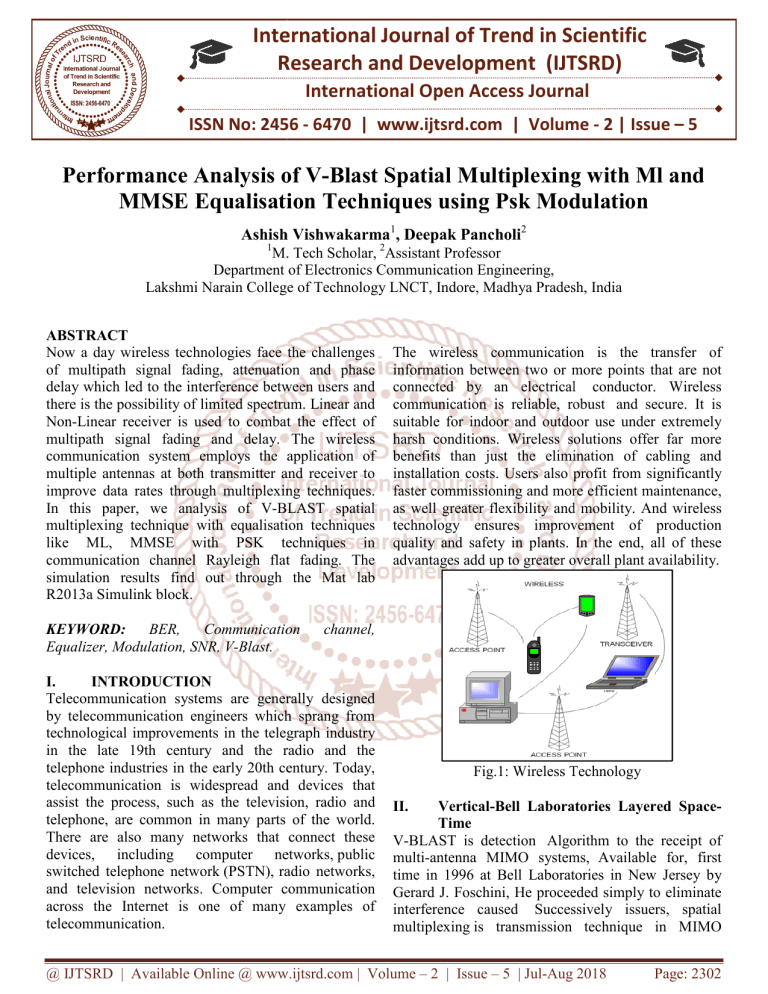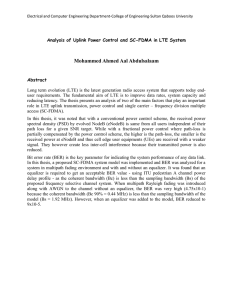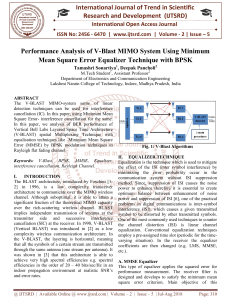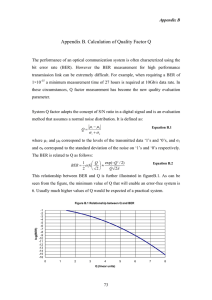
International Journal of Trend in Scientific
Research and Development (IJTSRD)
International Open Access Journal
ISSN No: 2456 - 6470 | www.ijtsrd.com | Volume - 2 | Issue – 5
Performance Analysis of V-Blastt Spatial Multiplexing with
w Ml and
MMSE Equalisation Techniques u
using
sing Psk Modulation
Ashish Vishwakarma1, Deepak Pancholi2
1
M. Tech Scholar, 2Assistant Professor
Department of Electronics Communication Engineering
Engineering,
Lakshmii Narain College of Technology LNCT, Indore, Madhya Pradesh,
Pradesh India
ABSTRACT
Now a day wireless technologies face the challenges
of multipath signal fading, attenuation and phase
delay which led to the interference between users and
there is the possibility of limited spectrum. Linear and
Non-Linear
Linear receiver is used to combat the eeffect of
multipath signal fading and delay. The wireless
communication system employs the application of
multiple antennas at both transmitter and receiver to
improve data rates through multiplexing techniques.
In this paper, we analysis of V-BLAST
BLAST spatial
multiplexing technique with equalisation techniques
like ML, MMSE with PSK techniques in
communication channel Rayleigh flat fading. The
simulation results find out through the Mat lab
R2013a Simulink block.
KEYWORD:
BER,
Communication
Equalizer, Modulation, SNR, V-Blast.
The wireless communication is the transfer of
information
ion between two or more points that are not
connected by an electrical .conductor. Wireless
communication is reliable, robust.
robust and secure. It is
suitable for indoor and outdoor use under extremely
harsh conditions. Wireless solutions offer far more
benefitss than just the elimination of cabling and
installation costs. Users also profit from significantly
faster commissioning and more efficient maintenance,
as well greater flexibility and mobility. And wireless
technology ensures improvement of production
quality
lity and safety in plants. In the end, all of these
advantages add up to greater overall plant availability.
channel,
I.
INTRODUCTION
Telecommunication systems are generally designed
by telecommunication engineers which sprang from
technological improvements in the telegraph industry
in the late 19th century and the radio and the
telephone industries in the early 20th century. Today,
telecommunication is widespread and devices that
assist the process, such as the television, radio and
telephone, are common in many parts of the world.
There are also many networks that connect these
devices, including
ncluding computer networks, public
switched telephone network (PSTN), radio networks,
and television networks. Computer communication
across the Internet is one of many examples of
telecommunication.
Fig.1: Wireless Technology
II.
Vertical-Bell
Bell Laboratories Layered SpaceSpace
Time
V-BLAST is detection. Algorithm to the receipt of
multi-antenna
antenna MIMO systems,
systems Available for, first
time in 1996 at Bell Laboratories in New Jersey by
Gerard J. Foschini, He proceeded simply to eliminate
interference caused. Successively issuers,
issuers spatial
multiplexing is transmission
ssion technique in MIMO
@ IJTSRD | Available Online @ www.ijtsrd.com | Volume – 2 | Issue – 5 | Jul-Aug
Aug 2018
Page: 2302
International Journal of Trend in Scientific Research and Development (IJTSRD) ISSN: 2456-6470
2456
wireless communication to transmit independent and
separately encoded data signals. Therefore, the space
dimension is reused, more than one time. V
V-BLAST is
one of the better techniques of spatial multiplexing.
Although-BLAST is essentially a single
single-user system
which uses multiple transmitters, one can
can. Naturally
ask in what ways the BLAST approach differs from
simply using traditional. Multiple access tech
techniques in
a single-user fashion i.e. by driving all the transmitters
from. A single user’s data which has been split into
sub streams. Some of these differences are
are. Worth
pointing out: First, unlike code division or other
spread-spectrum
spectrum multiple access techniques, the total
total.
Channel bandwidth utilized in a BLAST system is
only a small fraction in excess of the. Symbol rate, i.
e. similar to the excess bandwidth requir
required by a
conventional QAM system,
IV.
EQUALIZERS
The equalizer is a linear filter provides an
approximate inverse of the channel response. Since it
is common for the channel
channe characteristics to be
unknown or to change over time, in digital
communications, purpose of equalizer is to reduce
inter symbol interference to allow recovery
recover of the
transmit symbols. The ISI is imposed on the
transmitted signal due to the band limiting effect of
the practical channel.
A. Linear Equalizer:
A linear equalizer can be implemented as a FIR filter.
It is also known as transversal filter. This type of
equalizer is the simplest type available filter. In such
equalizer, the current and past values of the received
signal are linearly weighted by the filter coefficients.
B. MMSE Equalizer:
MMSE designs the filter to minimize E [|e|2], where e
is the error signal. Mean square error algorithm takes
the output of the antennas and tries to minimize the
mean error of the signal. It mainly concentrates on
noise power level rather than removing ISI.
Fig. 2: V-BLAST technology
III.
Additive White Gaussian Noise Channel
Additive White Gaussian Noise (AWGN
AWGN).is a channel
model in which the only impairment to
communication is a linear addition of wideband with a
constant spectral density and a Gaussian distribution
of amplitude. The model does not account for fading
frequency selectivity, interference, nonlinearity or
dispersion. However, it produces simple and tractable
mathematical models which are useful for gaining
insight into the underlying be havior of a system
before these other phenomena are considered.
Wideband Gaussian noise comes from many natural
sources, such as the thermal vibrations of atoms in
conductors shot noise, black body radiation from the
earth and other warm objects, and from celestial
sources such as the Sun. the
he figure 3 shown AWGN
channe
Fig. 3: AWGN Channel
C. Zero Forcing Equalizer:
It approximates the inverse of the channel
cha
with a
linear filter. It tries to force bit error rate to set on zero
using successive iterations. This equalizer is used
when the level of added noise is very low, and so it is
rarely used. Zero Forcing Equalizer is a linear
equalization algorithm used
ed in communication
systems; it inverts the frequency response of the
channel, which was proposed by Robert Lucky. The
Zero-Forcing
Forcing Equalizer applies the inverse of the
channel to the received signal. The name Zero forcing
corresponds to bringing down the Inter Symbol
Interference (ISI) to zero in a noise free case.
V.
SIMULATION RESULTS
The BER performance of the equalizers is compared
with respect to the variation in Eb/No (dB) as seen
from the simulation scripts. The used modulation
techniques are BPSK and QPSK and the considered
communication channel.
Table I: Simulation Parameters
Parameters
Values
Technology
V-BLAST
Algorithm
MMSE, ML
Modulation Techniques
PSK
Channel
Communication channel
Tool
Mat lab R2013a
@ IJTSRD | Available Online @ www.ijtsrd.com | Volume – 2 | Issue – 5 | Jul-Aug
Aug 2018
Page: 2303
International Journal of Trend in Scientific Research and Development (IJTSRD) ISSN: 2456-6470
The preferred technique for improving BER
performance is V-BLAST. The data is sent through
the no. of transmitting antennas and the no. of
receiving antennas is used for reception. The above
considered technologies have been combined using
the MATLAB R2013a software.
ML equalizer with QPSK System with VBLAST
0
10
MLBER11
MLBER22
MLBER33
MLBER44
-1
10
-2
A. Performance of MMSE Equalizer with QPSK
System
The number of transmitting and receiving antennas is
increase in the MIMO system with QPSK modulation
technique MMSE equalizer performance increases. It
is seen from the figure 4, that for 1-transmitter and 1receiver antenna system the min value of BER is
0.015 and the max value of BER is 0.15. For 2transmitters and 2-receivers antenna system the min
value of BER is 0.004 and the max value of BER is
0.11. Similarly, for 3-transmitters and 3-receivers
antenna system the min value of BER is 0.002 and the
max value of BER is 0.08. Now consider 4transmitters and 4-receivers antenna system the min
value of BER is 0.0019 and the max value of BER is
0.086.
MMSE equalizer with QPSK System with VBLAST
0
10
MMSEBER11
MMSEBER22
MMSEBER33
MMSEBER44
-1
BER
10
BER
10
-3
10
-4
10
-5
10
-6
10
0
2
4
6
8
EbNo (dB)----------->
10
12
Fig. 5: ML Equalizers with different MIMO system
VI.
CONCLUSION
Wireless communication is one of the most
demanding areas of the communication. The Vertical
Bell Labs Layered Space Time (V-BLAST)
associated with MIMO system increases the
performance of system in terms of Bit error Rate
(BER). It also reduces overall computational
complexity at the receiver. Minimum Mean Square
Error (MMSE) equalizer with V-BLAST at the
receiver increases performance of the system.
-2
10
-3
10
0
2
4
6
EbNo (dB)----------->
8
10
12
Fig. 4: MMSE Equalizers with different MIMO
system
B. Performance of ML Equalizer with QPSK
System
The number of transmitting and receiving antennas is
increase in the MIMO system with QPSK modulation
technique ML equalizer performance increases. It is
seen from the figure 5 that for 1*1 antenna system the
min value of BER is 0.015 and the max value of BER
is 0.15. For 2*2 antenna system the min value of BER
is 0.0013 and the max value of BER is 0.078.
Similarly, for 3*3 antenna system the min value of
BER is 0.00007 and the max value of BER is 0.042.
Now consider 4*4 antenna system the min value of
BER is 0.000002 and the max value of BER is 0.027.
REFERENCES
1. Nirmalendu Bikas Sinha, S. Chakraborty, P. K.
Sutradhar, R. Bera, and M. Mitra, “Optimization
of MIMO Detectors: Unleashing the Multiplexing
Gain” Journal of Telecommunication, Vol.1, 335342, Feb. 2011.
2. K. Sai Priyanjali and B. Seetha Ramanjaneyulu
“Performance Analysis of MIMO OFDM System
for Different Channel Lengths and Interference
Cancellation Techniques” International Journal of
Control Theory and Applications, Vol. 10(28), pp.
93-98, 2017.
3. Rupali Shrivastava, Mr. Virendra Verma “A
Review on the Performance of MIMO OFDM
Systems with VBLAST Technique” International
Journal of Engineering Research and Reviews,
Vol. 3(2), pp. 81-85, 2015.
4. Vikash Kumar Tiwary, Subham Agarwal
“Performance Analysis of Non-Linear Equalizer
@ IJTSRD | Available Online @ www.ijtsrd.com | Volume – 2 | Issue – 5 | Jul-Aug 2018
Page: 2304
International Journal of Trend in Scientific Research and Development (IJTSRD) ISSN: 2456-6470
in MIMO System for Vehicular Channel” I.J.
Image, Graphics and Signal Processing, Vol. 11,
pp. 68-75, 2013.
5. Samarendra Nath Sur “Channel Capacity and BER
Performance Analysis of MIMO System with
Linear Receiver in Nakagami Channel” I. J.
Wireless and Microwave Technologies, Vol. 1,
pp. 26-36, 2013.
6. Kritika Prasher and Ameeta Seehra “Performance
Evaluation of V-BLAST MIMO System Using
Rayleigh & Rician Channels” International
Journal of Information & Computation
Technology, Vol. 4(15), pp. 1549-1558, 2014.
7. Sindhi Mohsin “Analysis and Evaluation Of VBlast Mimo Of dm System Using Various
Detectors With Rician And Rayleigh Channel”
IJSRD - International Journal for Scientific
Research & Development, Vol. 2(3), 2014.
8. Samarendra Nath Sur, “Performance Analysis of
V-BLAST MIMO System in Rician Channel
Environment”, Journal of Theoretical and Applied
Information Technology, Vol. 2, 597-601, Sep.
2011.
9. Nagarajan Sathish Kumar, K. R. Shankar Kumar
“Bit Error Rate Performance Analysis of ZF, ML
and MMSE Equalizers for MIMO Wireless
Communication Receiver”, European Journal of
Scientific Research, Vol.59, 522-532, April 2011
10. Ho Ting, Kei Sakaguchi, and Kiyomich satish
kumar , “Optimization of LSE and LMMSE
Channel Estimation Algorithms based on CIR
Samples and Channel Taps”, IJCSI International
Journal of Computer Science Issues, Vol. 8, 437442, January 2011
11. Araki, “On the Practical Performance of VBLAST”, Journal of Telecommunication, Vol. 1,
1-8, Nov. 2002.
12. R. Bera, “Capacity and V-BLAST Techniques for
MIMO Wireless Channel” Journal of Theoretical
and Applied Information Technology, Vol. 2 (1),
57-62, Aug. 2011.
@ IJTSRD | Available Online @ www.ijtsrd.com | Volume – 2 | Issue – 5 | Jul-Aug 2018
Page: 2305





